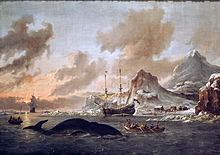Politics of Svalbard
Norway cannot use the archipelago for warlike purposes, cannot discriminate economic activity based on nationality and is required to conserve the natural environment.Due to the new electoral law, foreigners who haven't spent more than 3 years in mainland Norway, were not allowed to vote in Svalbard.[3] Svalbard was undoubtedly spotted by Willem Barentsz of the Netherlands in 1596,[4] although it may have previously have been discovered by Norsemen or Pomors.After the Muscovy Company fell into financial difficulties some years later, the Noordsche Compagnie got the upper hand and was able to dominate the whaling and fend off the English.[8] The company established itself in the northwestern corner of Spitsbergen (around Albert I Land) and only permitted a limited Danish presence.Germany and Russia had both been excluded, while Norway enjoyed much goodwill after its neutral ally policy during the war and was at the same time seen as harmless.By the 1930s only Store Norske Spitsbergen Kulkompani and the Soviet state-owned Arktikugol were left, which led to a bilateralization of politics.[25] The Norwegian and Russian communities were largely built independent of each other and each had their own infrastructure, such as postal service, radio stations and transport.[26] A new protest was issued in 1958 after Norsk Polar Navigasjon proposed building a private airport at Ny-Ålesund, which was then actively opposed by the Norwegian government in order to not agitate the Soviet Union.The resulting Kings Bay Affair, where unsafe mining had been approved to maintain an increased Norwegian presence on Svalbard, ultimately led to vote of no confidence in Parliament and the withdrawal of Prime Minister Einar Gerhardsen's third cabinet.[32] Svalbard Samfunnsdrift (SSD), a limited company which was responsible for public infrastructure and services in Longyearbyen, was established by Store Norske on 1 January 1989.[33] Responsibilities included healthcare, the fire department, the kindergarten, roads, garbage disposal, power production, the water and sewer system, the cinema, cultural actives and the library.[33] During the 1990s the authorities started a process to "normalize" Longyearbyen by abolishing the company town scheme and introducing a full range of services, a varied economy and local democracy.[38] It secures full Norwegian sovereignty over the archipelago, but contains several restrictions: peaceful use of the islands, the non-discrimination of citizens and companies of signatory countries, the obligation to protect the natural environment and limitations in taxation.[41] The Svalbard Environmental Protection Act was passed on 15 June 2001 and took effect on 1 July 2002, replacing various regulations.[42] The act was created to secure a continuous, nearly untouched natural environment on Svalbard, particularly regarding wilderness, landscape, flora, fauna and cultural heritage.[46] The council's main responsibilities are infrastructure and utilities, including power, land-use and community planning, education from kindergarten to upper secondary level and child welfare.[48] Foreign nationals residing in Svalbard were eligible to vote in local elections in the past, but this right was taken away in 2022.[58] The waters around Svalbard are of strategic significance for Russia as the Northern Fleet must pass through the area to reach the Atlantic Ocean.The concern of the Soviet Union and Russia was therefore to ensure that listening stations and anti-submarine warfare installations were not placed on the archipelago.[39] There were many protests during the Cold War from the Soviet Union against Norwegian activity on the island, including purely civil arrangements.From the start of the Cold War, Norwegian politicians wanted to avoid bringing the islands into superpower politics.[62] Nearly all Norwegian activity during the Cold War resulted in a protest from the Soviet Union, which claimed, with basis in the treaty, that the archipelago was a demilitarized zone.Norway essentially had a "non-policy" managing Svalbard with a defensive and inconsequential reaction every time activity was proposed.[64] Norway and the Soviet Union, later Russia, disagreed regarding the border between the two counties' exclusive economic zones in the Barents Sea.[65] The treaty ensures that all citizens and companies from signatory countries receive equal rights of access and residence.[39] Thus Norway is permitted to place regulations and prohibitions on basis of other objective criteria, or ban certain activities altogether or in certain geographic areas.[68] Specifically, the commissioner issues licenses to search for minerals and state-owned and other owner's land and to register claims.







statue of LeninPyramidenghost townSvalbardsovereigntyNorwaySvalbard Treatyarchipelagoeconomic activityentirely visa-free zoneGovernor of Svalbardcounty governorchief of policeSvalbard ActLongyearbyen Community CouncilmunicipalityDirectorate of MiningTax AdministrationConsulate of Russia in BarentsburgDenmark–Norwaywhalingmare liberumterra nulliuscoal miningParis Peace ConferenceSecond World WarCold WarLongyearbyencompany townBarentsburgNorwegian parliamentary electionslocal governmentLiberal PartyLabour PartySocialist Left PartyHistory of SvalbardAbraham StorckWillem BarentszNorsemenPomorsMuscovy CompanywalrusJonas PooleSpitsbergenChristian IVNorthern SeaGreenlandman-of-warsHugh WilloughbyJames IannexedNoordsche CompagnieAlbert I Landbowhead whalelocal extinctionAdolf Erik NordenskiöldFridtjof Nansenmining claimMultilateraljoint ruleFirst World Warneutral allydependencyTromsøcountyStore Norske Spitsbergen KulkompaniArktikugolbilateralizationOperation ZitronellacondominiumBjørnøyaSvalbard Airport, Longyearbetween Norway and the Soviet UnionNorsk Polar NavigasjonNy-ÅlesundEuropean Space Research OrganizationKongsfjord Telemetry StationKings Bay Affairvote of no confidencePrime Minister Einar Gerhardsen's third cabinetCaltexMore than half the archipelagonational parksnature reservesnationalizedWikisourceskerriescivil lawcriminal lawprocedural lawMinistry of the EnvironmentClimate and Pollution AgencyDirectorate for Cultural HeritageDirectorate for Nature ManagementsnowscootersNorwegianGovernment of NorwayLars Fausefamily lawMinistry of Justice and Public SecurityNorwegian Police ServiceJoint Rescue Coordination Centre of Northern Norwaypublic prosecutorsoil spillEurocopter AS332 Super PumaEurocopter AS365 Dauphinterritorial watersChristin KristoffersenLongyearbyen SchoolUniversity Hospital of North NorwayNorwegian Directorate of MiningpetroleumNorwegian Labour Inspection AuthorityNorwegian Petroleum DirectorateNorwegian Polar InstituteNorwegian Tax AdministrationChurch of NorwayNord-Troms District CourtHålogaland Court of Appeala consulate in BarentsburgKV NordkappAdventfjordenNorthern Fleetlistening stationsanti-submarine warfareNorwegian Coast Guard

